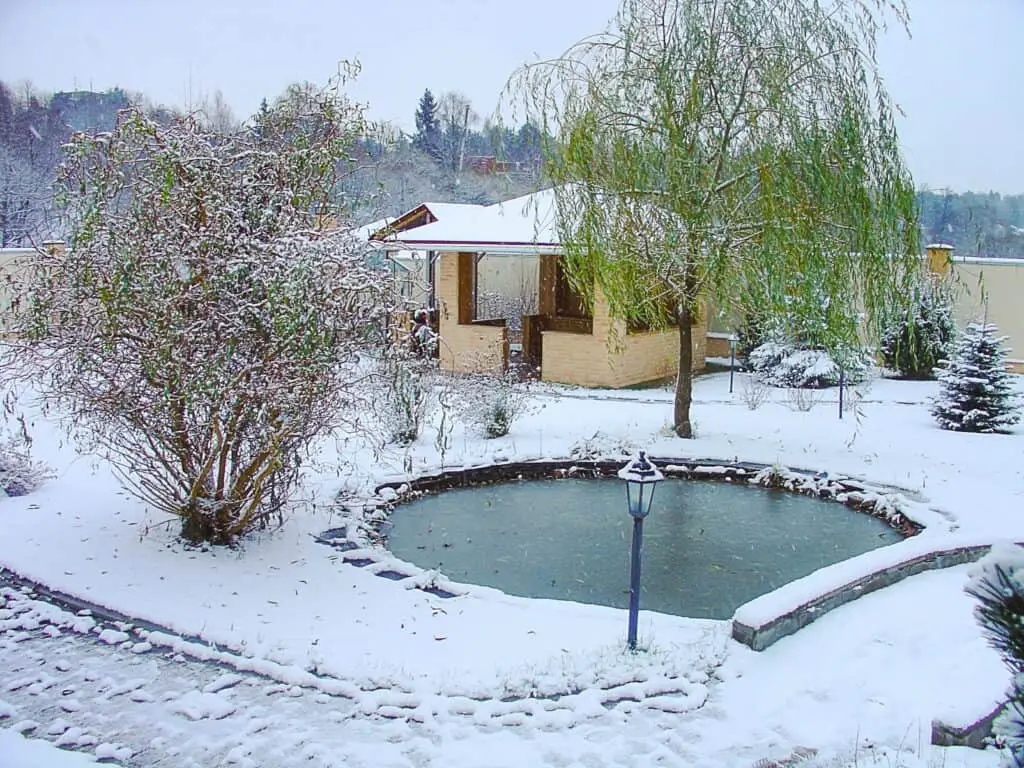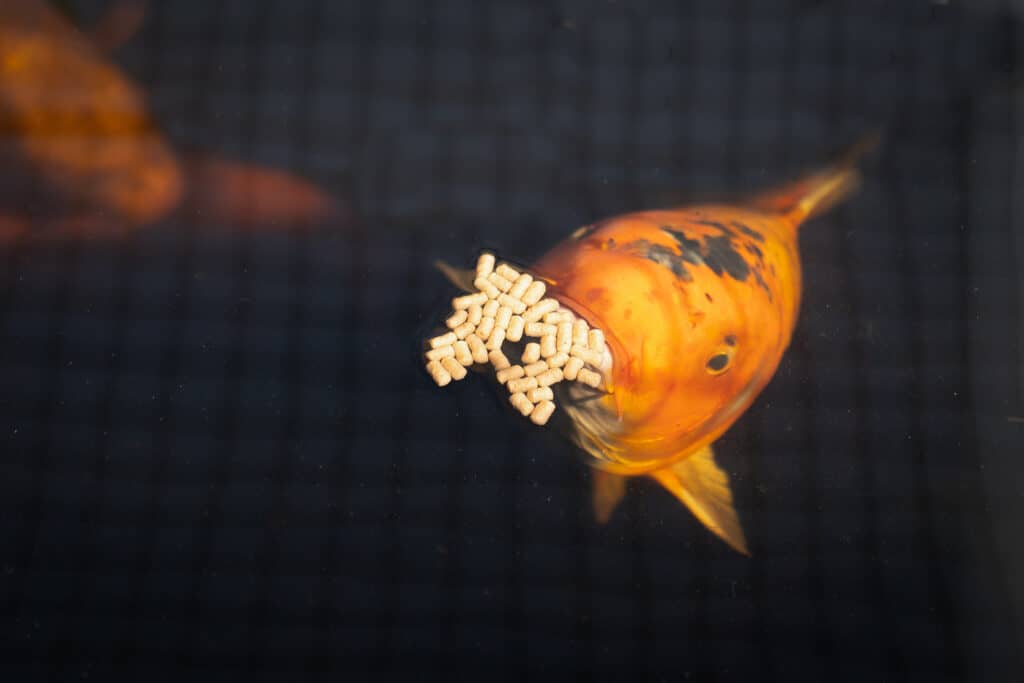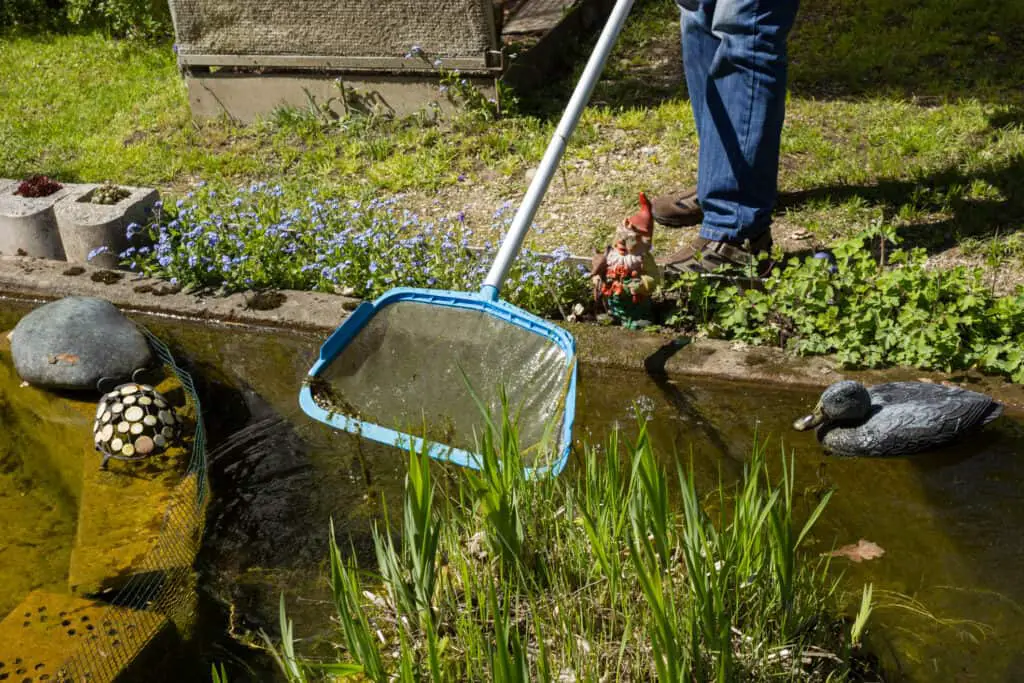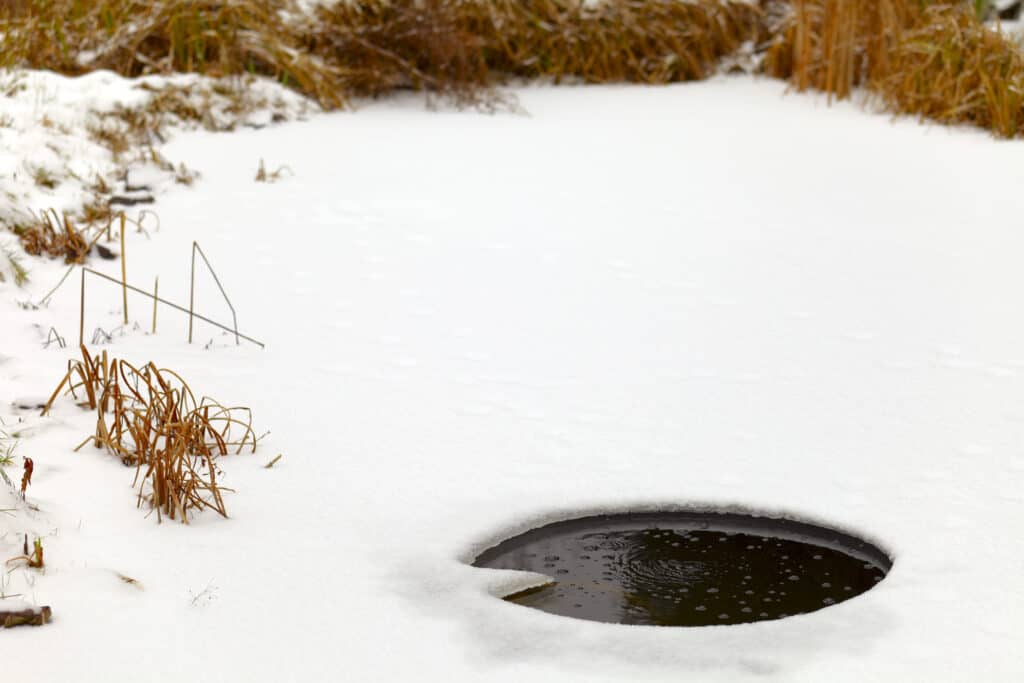
We all love our koi fish. They are like children to us, only in fish form. We want to protect our pride-and-joy koi when winter shows its freezing face. Winterizing your koi pond should be hassle-free. Here are 7 steps that you can follow to protect your koi, koi pond, and koi pond equipment during winter.
Here are 7 steps to winterizing your koi pond:
- Feed your koi healthy food
- Treat the pond with healthy bacteria
- Medicate the pond and koi against parasites
- Clean the pond
- Attend to the pond plants
- Shut down the pond
- Keep a hole open in the ice
Winterizing your koi pond should start in the fall months and generally form part of your general maintenance routine. By keeping your pond and koi in a healthy state throughout the year, there’s less to do when winter comes along. Winterizing your koi pond is easy when your koi pond is a healthy functioning unit.
Pro Tip: If you’re tired of wasting money and making costly mistakes on the koi-keeping hobby or are thinking about buying koi fish but don’t know where to start, I strongly suggest you check out this ebook. I recently read this ebook, and it contains SO much useful information, such as:
- 3 proven steps to identify koi fish diseases
- WARNING: 3 things you should NEVER do when it comes to caring for koi
- When to seek professional help when it comes to looking after your koi
Do I Need To Winterize My Koi Pond?
A smart koi owner winterizes their koi pond. Preparing the pond, and protecting your beloved koi, should be high on your priority list as the cold, dark winter approaches. Koi are hardy fish, but every little bit of help on offer could be the difference in surviving winter or not.
Your preparation for the winter months should start in the fall; some winterizing steps should be done throughout the year as part of your koi pond maintenance routine. It would help if you winterized your koi pond to ensure that:
- Your koi survive the winter, and they’re all healthy and alive when spring rolls around.
- Your koi pond equipment doesn’t get damaged by the freezing weather, and it’s cleaned and stored away, ready to get back to work when needed.
- Your koi pond environment is protected from organic debris (decomposing plant material, fish waste, and plant material) that cause poor water quality, elevated nitrite and ammonia levels, a breeding ground for algae, fish parasites, and low levels of oxygen.
- Your koi pond plants that won’t survive the winter are taken out, and those that can survive the cold, are prepared for winter.
The koi will enter a hibernation state called torpor during the winter months (usually when the water temperature drops below 50°F).
The metabolism of koi fishes shuts off completely, so all preparation should be done before this occurs, which includes feeding them properly one last time.
Follow the following steps to ensure that you winterize your koi pond effectively, protecting your beloved and prized koi fish healthy and alive for your reunion in spring.
Steps To Winterize Your Koi Pond
“Winter is coming” should not send any shivers down your spine. We are quite safe in our heated homes with big fireplaces, hot cocoa, and bed warmers. But what about our fishy koi surviving a whole winter outside in the freezing temperatures?
Here are several steps that you can take to ensure that your koi’s winter experience is as comfortable and safe as yours:
Step 1 – Feed Your Koi Healthy Food

You become what you eat is often thrown at us humans: it should also be applied to your koi. Feeding them a well-balanced diet throughout the year is essential in creating healthy and happy fish. During the winter, your koi will live off stored body resources accumulated throughout the year.
Feed your koi with the following foods throughout the year, especially in the cold-water temperatures (below 60°F) of the fall months:
- Kodama Koi Food – Wheat Germ (All-Season)
- Blue Ridge Probiotic Plus
- Hikari USA Gold
- Aquascape Premium Staple Pond and Koi Fish Food
All koi fish enjoys a treat or two, so give them Mandu Fu Koi Food (Overall digestion rate of 98.2%). Mandu Fu can be fed to your koi in water temperatures as low as 45°F, as the product was designed for low-temperature feeding and contains Manda Nishiki – a nutritional enzyme.
When the water temperature hits 50°F, your koi will, out of necessity, go into hibernation, from which you should not disturb them.
If your winters are not as cold and icy as in the northern parts of the United States, then feeding them a Mandu Fu treat on more “active” winter days won’t do any harm.
Step 2 – Treat The Pond With Healthy Bacteria
To help keep the koi pond water clean during the winter months, you have to treat the pond by adding beneficial bacteria to the water system. Beneficial bacteria help digest excess nutrients and debris that can cause trouble.
- Treating the pond with Aquascape Cold Water Beneficial Bacteria should do the trick as it reduces nitrite, ammonia, and organic debris in the water (as cold as 35°F.)
Step 3 – Medicate The Koi And Pond Against Parasites
Ideally, it would be best to medicate your pond twice a year, once in the fall and spring. The lower temperatures make koi more vulnerable as their bodies and immune systems adapt to winter conditions.
Making sure that the pond, and most importantly your precious koi, is parasite-free before going into winter is a step that needs doing. Treatment can be commenced at around 50-55°F.
Harmful pathogens and parasites will also be dormant during the winter months, but they will come to live much quicker than the koi when spring arrives. Ensure the pond is parasite-free when they “wake up” from their winter sleep.
Protect your vulnerable koi by using products like these:
Step 4 – Clean The Pond

Clean all leaves and any debris from the pond area. Use a pond scooping net or a pond vacuum cleaner for bigger ponds. Leaves start falling in the fall months. Installing a pond net during this time will help keep your pond free of leaves and debris.
Don’t leave the net on when the snow starts falling, as the net could struggle to handle the weight of the snow.
Step 5 – Attend To The Pond Plants
Make sure to trim any dead foliage from any hardy marginal plants living in your pond:
- Reeds
- Grasses
- Hibiscus
- Horsetails
- Irises
- Sweet Flag
- Rushes
- Water Lillies
Marginally hardy plants can potentially survive winter but will die if their crown freezes, so submerge them below the usual ice line:
- Water Clover
- Water Canna
- Pickerel
- Society Garlic
Tropical plants don’t survive the winter. Either choose to add them to the compost heap or bring the following plants inside and place them in a water container with sufficient light:
- Papyrus
- Taro
- Bog Lily
- Umbrella Palm
- Cannas
Step 6: Shut Down The Pond
Many homeowners decide to shut down their koi ponds during the winter to protect their pond equipment, which can be damaged when the freezing starts.
- Remove the pond pump: Clean it thoroughly and store it in the shed or garage.
- Direct drive style pumps should be stored in a bucket of water which will help to keep the pump’s seals moist.
- Asynchronous or magnetic drive pumps should be cleaned and stored in a dry state.
- Drain any water out of the plumbing system – standing water expands when it freezes – and can potentially crack the piping that connects your filtration system.
- Drain the water from pressurized filters – remove filter bio-media and filter pads. Proceed to clean them before replacing them inside the filter. Ensure that you don’t lose gaskets or O-rings.
- Drain the water from flow-through or gravity filters, clean them thoroughly, and store them in a safe place inside. If you choose to leave them outside, make sure to leave the drain valve open.
- Shut down the waterfall and make sure you leave an aerator (bubbler pump or a diffuser plate) on or install one.
- Disconnect your UV lights, clean them, and store them away.
Step 7: Keep A Hole Open In The Ice

Keeping a part of your koi pond free from ice is crucial for air exchange and your koi survival.
A floating pond heater/de-icer will do the job, and paired with an aeration pump or diffuser plate, your winter koi pond aeration will be up to standard.
Must I Cover My Koi Pond In The Winter?
Cover your koi pond during the winter, as the cover will ensure that the water stays warmer and keep debris out of the pond. A cover could prevent the pond from icing over.
Some koi owners find that covering their koi pond with a solar cover (typically used to cover swimming pools) is the easiest method. Other koi lovers go way out and construct a greenhouse around and over their koi ponds.
Whatever your preferred method, always have an aeration pump working, and don’t forget the de-icer if you stay in extremely cold weather.
Conclusion
The winterization of your koi pond typically starts in fall. When winter is around the corner, you would have done most of the preparation, and then it’s just holding your thumbs that your koi makes it through the icy winter – which they tend to do without any problem.
Give your koi the very best chance of survival by following the winterization steps listed in the article.
References:
https://www.aquascapeinc.com/water-gardening/maintenance-and-care/winterizing-your-pond
https://www.thepondguy.com/learning-center/overwintering-koi-and-goldfish-in-your-pond/
https://www.pondexperts.ca/pond-advice-tips/how-to-winterize-your-pond/ https://www.kodamakoifarm.com/winter-koi-pond-preparation-survival/#winterize-koi

